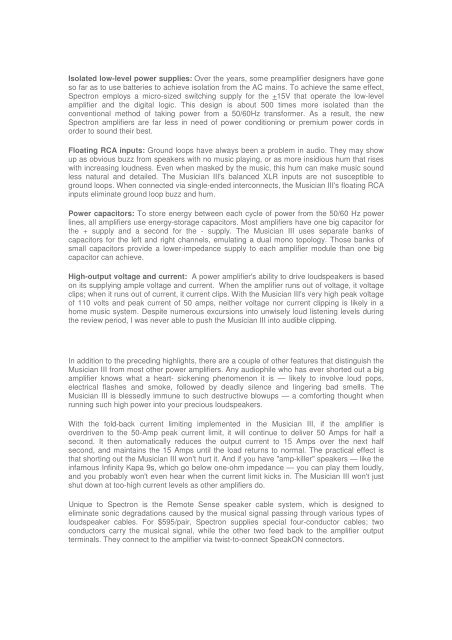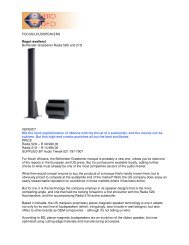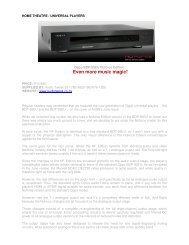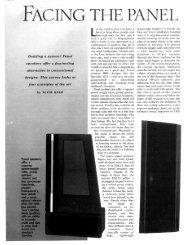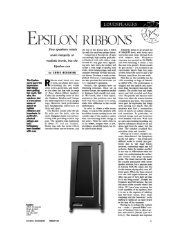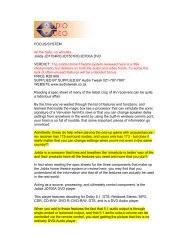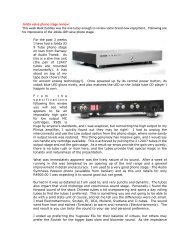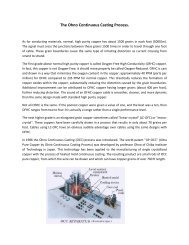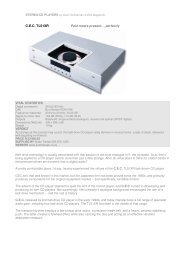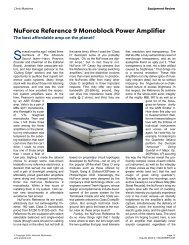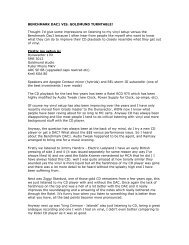Wayne Donnelly - Audio Tweak
Wayne Donnelly - Audio Tweak
Wayne Donnelly - Audio Tweak
Create successful ePaper yourself
Turn your PDF publications into a flip-book with our unique Google optimized e-Paper software.
Isolated low-level power supplies: Over the years, some preamplifier designers have gone<br />
so far as to use batteries to achieve isolation from the AC mains. To achieve the same effect,<br />
Spectron employs a micro-sized switching supply for the +15V that operate the low-level<br />
amplifier and the digital logic. This design is about 500 times more isolated than the<br />
conventional method of taking power from a 50/60Hz transformer. As a result, the new<br />
Spectron amplifiers are far less in need of power conditioning or premium power cords in<br />
order to sound their best.<br />
Floating RCA inputs: Ground loops have always been a problem in audio. They may show<br />
up as obvious buzz from speakers with no music playing, or as more insidious hum that rises<br />
with increasing loudness. Even when masked by the music, this hum can make music sound<br />
less natural and detailed. The Musician III's balanced XLR inputs are not susceptible to<br />
ground loops. When connected via single-ended interconnects, the Musician III's floating RCA<br />
inputs eliminate ground loop buzz and hum.<br />
Power capacitors: To store energy between each cycle of power from the 50/60 Hz power<br />
lines, all amplifiers use energy-storage capacitors. Most amplifiers have one big capacitor for<br />
the + supply and a second for the - supply. The Musician III uses separate banks of<br />
capacitors for the left and right channels, emulating a dual mono topology. Those banks of<br />
small capacitors provide a lower-impedance supply to each amplifier module than one big<br />
capacitor can achieve.<br />
High-output voltage and current: A power amplifier's ability to drive loudspeakers is based<br />
on its supplying ample voltage and current. When the amplifier runs out of voltage, it voltage<br />
clips; when it runs out of current, it current clips. With the Musician III's very high peak voltage<br />
of 110 volts and peak current of 50 amps, neither voltage nor current clipping is likely in a<br />
home music system. Despite numerous excursions into unwisely loud listening levels during<br />
the review period, I was never able to push the Musician III into audible clipping.<br />
In addition to the preceding highlights, there are a couple of other features that distinguish the<br />
Musician III from most other power amplifiers. Any audiophile who has ever shorted out a big<br />
amplifier knows what a heart- sickening phenomenon it is — likely to involve loud pops,<br />
electrical flashes and smoke, followed by deadly silence and lingering bad smells. The<br />
Musician III is blessedly immune to such destructive blowups — a comforting thought when<br />
running such high power into your precious loudspeakers.<br />
With the fold-back current limiting implemented in the Musician III, if the amplifier is<br />
overdriven to the 50-Amp peak current limit, it will continue to deliver 50 Amps for half a<br />
second. It then automatically reduces the output current to 15 Amps over the next half<br />
second, and maintains the 15 Amps until the load returns to normal. The practical effect is<br />
that shorting out the Musician III won't hurt it. And if you have "amp-killer" speakers — like the<br />
infamous Infinity Kapa 9s, which go below one-ohm impedance — you can play them loudly,<br />
and you probably won't even hear when the current limit kicks in. The Musician III won't just<br />
shut down at too-high current levels as other amplifiers do.<br />
Unique to Spectron is the Remote Sense speaker cable system, which is designed to<br />
eliminate sonic degradations caused by the musical signal passing through various types of<br />
loudspeaker cables. For $595/pair, Spectron supplies special four-conductor cables; two<br />
conductors carry the musical signal, while the other two feed back to the amplifier output<br />
terminals. They connect to the amplifier via twist-to-connect SpeakON connectors.


